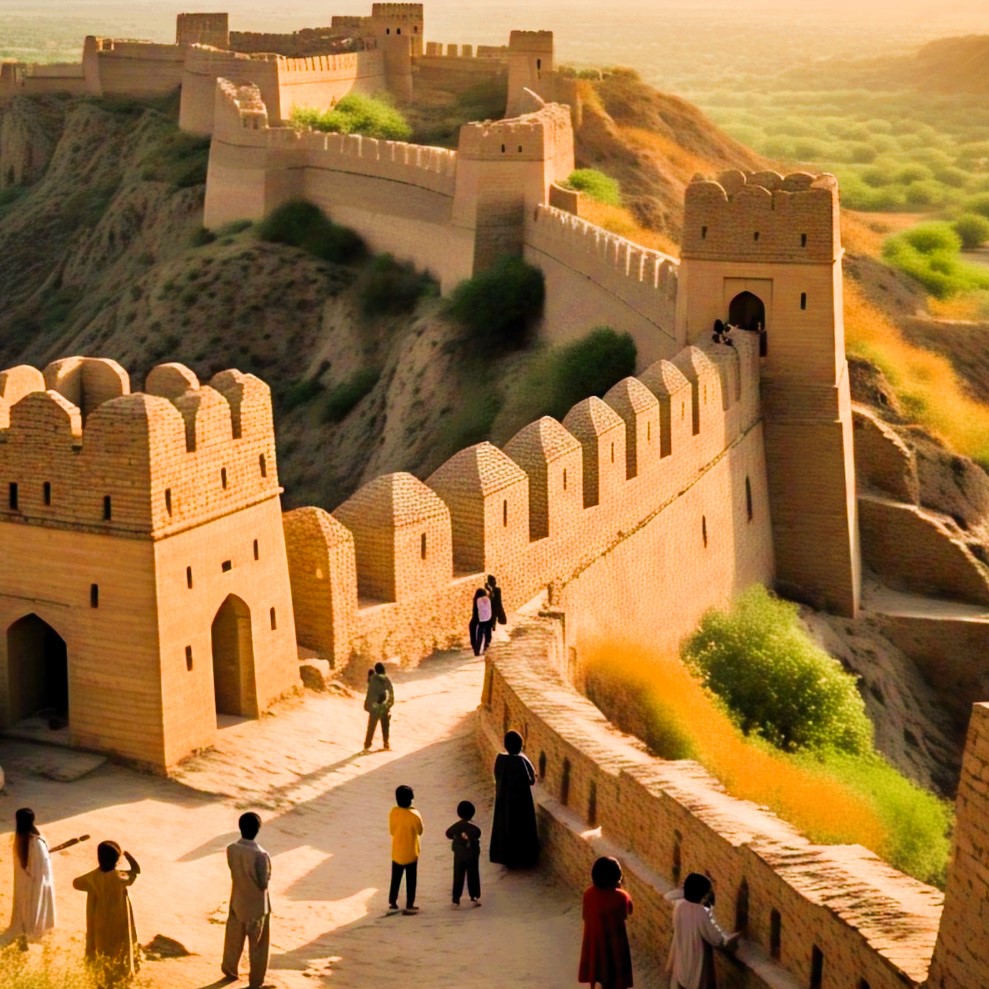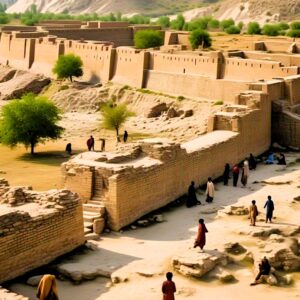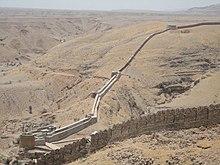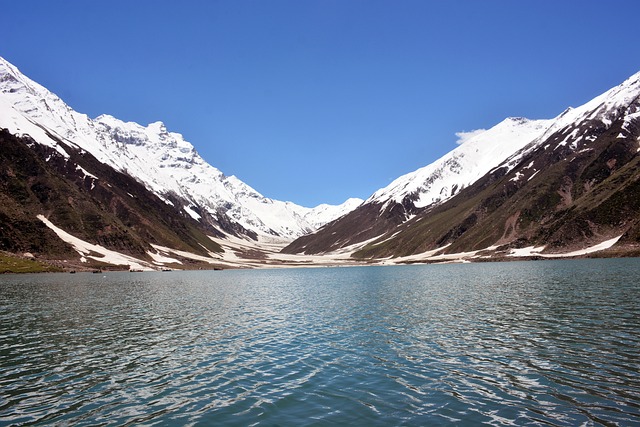The Wall of Sindh in Ranikot: A Hidden Gem of Pakistan to Explore in 2025
Have you ever heard of the Wall of Sindh in Ranikot? If not, you are not alone. This amazing structure is one of the most underrated and overlooked attractions in Pakistan, despite being one of the largest and oldest forts in the world. The Wall of Sindh in Ranikot, also known as the Great Wall of Sindh, is a 19th-century fortification that surrounds the Fort of Ranikot, a historical site near Sann in Jamshoro District, Sindh.
The wall is a marvel of engineering and architecture, stretching for more than 30 kilometres and enclosing an area of about 65 square kilometres. The wall is made of sandstone and lime mortar and has four gates, several bastions, watchtowers, and ravelins. The wall is also a mystery, as its origin and purpose are still unknown. Who built it, when, and why? These are the questions that intrigue and fascinate visitors and researchers alike.

If you are looking for a unique and adventurous destination for your next trip, then the Wall of Sindh in Ranikot is the place for you. In this article, I will share with you my experience of visiting this incredible site, and give you some tips and advice on how to plan your own trip.
How to get to the Wall of Sindh in Ranikot
The Wall of Sindh in Ranikot is about 260 kilometres away from Karachi, the largest city and the capital of Sindh. You can reach Karachi by plane, train, bus, or car from other cities in Pakistan or abroad. From Karachi, you can take a car or a bus to Sann, a small town on the Indus Highway, which is about 90 kilometres away from the wall. The journey will take you about three hours, depending on the traffic and the road conditions. You can also take a train to Sann, which will take you about four hours.
From Sann, you can take a local taxi or a rickshaw to the wall, which will cost you around 1000 to 1500 PKR. Alternatively, you can rent a bike or a car and drive yourself to the site, following the signs along the road. The road to the wall is rough and bumpy and passes through some rugged and scenic terrain.
You will also see the ruins of Aror, the ancient capital of Sindh, where the legendary Hindu king Raja Dahir ruled until he was defeated by the Muslim general Muhammad bin Qasim in 711 CE1. Aror was once a prosperous city, but it was destroyed by a massive earthquake in 962 CE, which also changed the course of the Indus River2.
The journey to the wall is an adventure in itself, as you will witness the beauty and diversity of Sindh’s landscape, culture, and history.
What to see and do at the Wall of Sindh in Ranikot
The Wall of Sindh in Ranikot is a sight to behold, as it rises from the ground and curves along the hills and valleys. The wall has four gates, each with a different name and design. The most used and accessible gate is the Sann Gate, which is on the eastern side of the wall. The Sann Gate is also the most impressive and ornate gate, with a double arch and a carved inscription.
The other gates are the Mohan Gate, the Amri Gate, and the Shah Pir Gate, which are on the western, northern, and southern sides of the wall, respectively. The Mohan Gate is the smallest and the simplest gate, while the Amri Gate and the Shah Pir Gate are larger and more elaborate.
The wall also has several bastions, watchtowers, and ravelins, which are small triangular fortifications that project from the wall. The bastions and watchtowers are located at regular intervals along the wall and provide a panoramic view of the surrounding area. The ravelins are located near the gates and provide extra protection and defence. The wall also has some loopholes and embrasures, which are small openings for firing weapons.
The wall encloses the Fort of Ranikot, which is a historical site that dates back to the 17th century. The fort is composed of several structures, such as palaces, mosques, temples, wells, and tombs. The fort also has a small village, where some local people live and work. The fort is a place of historical and cultural significance, as it reflects the diversity and harmony of Sindh’s heritage.
One of the most interesting and mysterious features of the fort is the Miri Kot, which is a small citadel within the fort. The Miri Kot is located on a hilltop and has a circular shape and a high wall. The Miri Kot is believed to be the oldest part of the fort, and some archaeologists suggest that it may have been built by the Sassanians, the Scythians, the Parthians, or the Bactrian Greeks3. However, there is no conclusive evidence to support this theory, and the origin and purpose of the Miri Kot remain a mystery.
You can also explore the natural beauty and wildlife of the area, as the wall and the fort are located within the Kirthar National Park, the second-largest national park in Pakistan4. The park is home to a variety of flora and fauna, such as leopards, wolves, hyenas, foxes, jackals, deer, antelopes, ibexes, wild goats, porcupines, hares, snakes, lizards, birds, and plants. The park also has some caves, springs, and waterfalls, which add to the charm and attraction of the place.

Where to stay and eat near the Wall of Sindh in Ranikot
If you want to spend more time at the Wall of Sindh in Ranikot, you can stay at one of the nearby hotels or guest houses, which offer basic facilities and reasonable prices. Some of the options are:
- Hotel Al-Habib: A budget hotel located in Sann, about 15 km from the wall. It has clean rooms with air conditioning, TV, and attached bathrooms. It also has a restaurant that serves local and Chinese cuisine. The hotel charges 1000 to 1500 PKR per night for a double room5.
- Hotel One Jamshoro: A mid-range hotel located in Jamshoro, about 50 km from the wall. It has spacious rooms with modern amenities, such as Wi-Fi, a minibar, and a coffee maker. It also has a fitness centre, a business centre, and a rooftop restaurant that offers a view of the Indus River. The hotel charges 4000 to 6000 PKR per night for a double room6.
- Indus Hotel: A luxury hotel located in Hyderabad, about 100 km from the wall. It has elegant rooms with premium amenities, such as LCD TV, DVD player, and jacuzzi. It also has a swimming pool, a spa, and a golf course. It also has a restaurant that serves international and local cuisine. The hotel charges 10000 to 15000 PKR per night for a double room7.
You can also camp near the wall if you have your tent and equipment. There is a flat area near the Sann Gate, where you can pitch your tent and enjoy the night sky. However, you have to be careful of the weather, the animals, and the security, as there is no official camping site or facility.
For food, you can try some of the local delicacies, such as Sindhi biryani, pulao, karahi, saag, and lassi. You can find these dishes at the roadside stalls and dhabas near the wall, or at the restaurants in Sann, Jamshoro, and Hyderabad. You can also buy some snacks and drinks from the shops near the wall, or bring your picnic basket.
Tips and advice for visiting the Wall of Sindh in Ranikot
Before you visit the Wall of Sindh in Ranikot, here are some tips and advice to make your trip more enjoyable and safe:
- The best time to visit the Wall of Sindh in Ranikot is from October to March when the weather is pleasant and cool. Avoid visiting in the summer, when the temperature can reach up to 50 degrees Celsius, and the wall can get very hot.
- Wear comfortable clothes and shoes, as you will have to walk and climb a lot. Also, bring a hat, sunglasses, and sunscreen, to protect yourself from the sun.
- Respect the environment and the culture of the people, especially when you visit the fort and the village. Do not litter or damage the wall or the structures on it. Also, do not take pictures or make noise, and dress modestly.
- Be careful of the snakes, scorpions, and other animals that may be hiding in the cracks and crevices of the wall. Do not touch or disturb them, and keep a safe distance.
- Carry enough water and food, as there are no proper facilities or shops at the site. Also, carry some cash, as there are no ATMs or card machines nearby.
- If you are travelling by yourself, inform someone about your whereabouts and plans, and keep your phone charged and handy. If you are travelling with a group, stick together and follow the instructions of your guide or leader.
-
The history of Fort Ranikot is not very clear, as there is no conclusive evidence about its origin and purpose. However, some archaeologists and historians have proposed different theories and hypotheses based on the available sources and findings.
One of the most accepted theories is that Fort Ranikot was built by the Talpur dynasty in the early 19th century, during the administration of Nawab Wali Muhammed Leghari, the Prime Minister of Sindh12. The fort was constructed as a defensive and administrative centre and was reinforced with a massive wall that surrounded the fort and the surrounding area.
The wall, which is also known as the Wall of Sindh or the Great Wall of Sindh, is one of the largest and longest fortifications in the world, with a circumference of about 32 kilometers12. The wall has four gates, each with a different name and design, and several bastions, watchtowers, and ravelins. The wall also has some loopholes and embrasures for firing weapons.
Another theory is that the Fort Ranikot was built by the Sassanians, the Scythians, the Parthians, or the Bactrian Greeks, who ruled over parts of Sindh and Balochistan in ancient times34. According to this theory, the fort was built as a strategic and military outpost and was later modified and expanded by the subsequent rulers, such as the Arabs, the Kalhoras, and the Talpurs.
The oldest part of the fort, according to this theory, is the Miri Kot, which is a small citadel within the fort, located on a hilltop. The Miri Kot has a circular shape and a high wall and is believed to date back to the 1st or 2nd century CE34.
However, none of these theories have been proven or verified by concrete evidence, and the history of Fort Ranikot remains a mystery. The fort is a subject of ongoing research and exploration, and discoveries and insights may shed more light on its past and significance.
The fort is also a cultural and natural heritage site, as it reflects the diversity and harmony of Sindh’s history, and is located within the Kirthar National Park, which is home to a variety of flora and fauna14.
If you want to learn more about the history of Fort Ranikot, you can visit the following links:
- Ranikot Fort – Wikipedia
- Ranikot Fort – History and Facts | History Hit
- Ranikot Fort | One of The Largest Fort in Jamshoro, Pakistan
- All you need to know about Ranikot Fort | Graana.com
Exploring the Cold Desert of Skardu 2024: A Hidden Gem in Northern Pakistan
